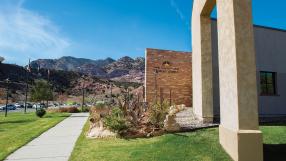You never know where a random conversation may lead – or how long the resulting idea may take to reach fruition.
For Brad Bowers, a faculty member of PCC’s history program, a friendly chat 20 years ago eventually resulted in the publication of “Bound by Steel & Stone,” his history of the shortline Colorado-Kansas Railway that ran through part of what is now Pueblo West.
“I had a friend who said a railroad used to run through Pueblo West,” Bowers said of the book’s origin. “There wasn’t a lot of information about it but that was enough to get me started.”
Bowers started college at age 30 as a computer information systems major but that conversation and the resulting project also led to a revised career path.
“I rediscovered my love of history and research,” he said, “so I changed my major to history.”
He graduated from Colorado State University Pueblo and his extensive research eventually ended up being the basis of his master’s thesis. He’s been at PCC since 2011, sharing his expertise and experiences with students.
The Colorado-Kansas Railway existed from 1912 to 1957 and ran northwest to Stone City, which now is part of Fort Carson. The railway primarily served the nearby clay mines and stone quarries; Turkey Creek sandstone was hauled to Pueblo for construction of multiple buildings, including the Pueblo County Courthouse.
Throughout the past two decades, Bowers continued gathering information about the railway and the local entrepreneurs, economics and politics of that era.
“In the early 20th century, a lot of people had crazy ideas of what they could do out here,” he said.
Students in Bowers’ Colorado History class have gotten a glimpse over the years of some of the stories that ended up in “Bound by Steel & Stone.”
They may have heard about George H. Paul, who decided to build a giant apple orchard on land near the railway. Bowers learned that his great-grandfather, Lu Caywood, was one of the men who moved his family to the area – then known as Appleton – to work building a barn at the (doomed) orchard.
Or maybe students learned about Puebloan Irma MacDaniel, a multitalented woman who operated the railroad from 1940 to 1957. She also worked in the insurance and real estate industries.
Not all of Bowers’ research was confined to historical documents and websites. Sometimes he got to hear about the area’s history from those who lived it.
“One of the things that was really memorable to me was when I got in touch with a group of ladies that grew up in Stone City in the ‘30s and ‘40s,” he said. “I had them out to my apartment in Pueblo West and just let them tell their stories.”
Pueblo’s story has countless chapters, many of which are already well documented. Bowers is pleased that he can add something fresh to the tale.
“For a lot of people, this is going to be brand new history,” he said.
“Bound by Steel & Stone” is available at Barnes & Noble and through Amazon.


